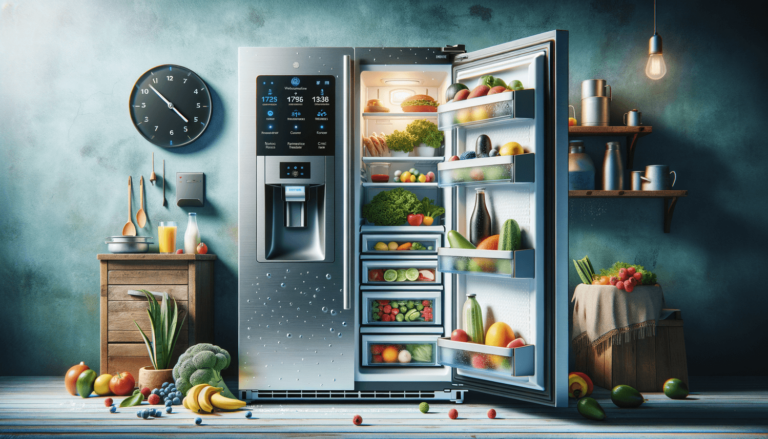

In today’s rapidly evolving world of technology, having the right refrigerator settings can make a huge difference in energy efficiency and food preservation. In this blog post, we’ll be diving into Whirlpool refrigerator settings explained, allowing you to make informed decisions for the optimal functionality of your appliance. Just as crucial as understanding Bosch refrigerator settings, these Whirlpool guidelines are sure to enhance your day-to-day life in the kitchen. So, let’s embark on this essential journey towards mastering your refrigerator’s settings
Whirlpool refrigerators come with adjustable temperature settings for both the refrigerator and freezer compartments. These settings ensure that your food stays fresh and properly frozen, respectively.
Some Whirlpool refrigerators come with a door alarm that alerts you when the door has been left open for a certain amount of time. This handy feature helps conserve energy and prevent food spoilage.
Whirlpool refrigerators may have fast cooling and fast freezing features, designed to quickly chill or freeze food items, especially after a grocery trip or when adding a large amount of food.
Many Whirlpool refrigerators include an adaptive defrost feature, which automatically calculates the optimal defrost frequency and duration for your particular usage pattern and environment.
Whirlpool refrigerators with built-in ice and water dispensers allow you to choose between various ice types and water temperatures.
These features help maintain proper humidity levels in the refrigerator, keeping your food fresh for extended periods.
As a proud member of the ‘Settings King’ community, we understand the importance of optimal refrigerator settings to prolong the freshness of your food items. Follow these quick tips to accomplish common functions using your Whirlpool refrigerator settings:
Use the correct refrigerator settings for your fruits and vegetables to maintain freshness and prevent spoilage. Place your produce in the crisper drawers and set the humidity controls according to the type of produce:
When planning to defrost or thaw frozen foods, ensure a safe and efficient process by using the built-in features:
Proper storage of dairy products in your Whirlpool refrigerator will ensure their freshness and taste. Follow these refrigerator settings tips:
To conserve energy and maximize the efficiency of your Whirlpool refrigerator, follow these practices:
An essential aspect of mastering your Whirlpool refrigerator settings is ensuring proper maintenance. By keeping your refrigerator clean and well-maintained, you’ll prolong its life, prevent malfunctions, and preserve your food more efficiently. As part of the ‘Settings King’ community, we’ve compiled some tips to keep your refrigerator running at its best:
Regularly clean your refrigerator’s interior to prevent the buildup of bacteria, mold, and unpleasant odors. Remove shelves, drawers, and other removable parts, and wash them with warm, soapy water. Wipe down the interior surfaces with a damp cloth and a mild cleaner. Rinse and dry all surfaces before replacing the shelves and drawers.
Keep your refrigerator’s exterior clean and smudge-free by wiping it down with a damp cloth and a mild cleaner. For stainless steel refrigerators, use a cleaner specifically designed for stainless steel to remove fingerprints and smudges. Wipe in the direction of the grain for the best results.
Regularly change your Whirlpool refrigerator’s water and air filters to ensure the best performance. Replace the water filter every six months or when the indicator light prompts you to. Replace the FreshFlow air filter every six months as well. Monitor the Produce Preserver sachets and replace them according to your refrigerator’s indicator light or the sachets’ color change.
Keep your refrigerator running efficiently by cleaning the condenser coils every six months to a year. Dust and dirt buildup on the coils can reduce your refrigerator’s efficiency, leading to higher energy consumption. Unplug the refrigerator, then use a vacuum cleaner or a brush to gently clean the coils, ensuring that you don’t damage other components in the process.
Understanding your Whirlpool refrigerator settings is just the beginning. As a ‘Settings King’ enthusiast, you can tap into a wealth of knowledge for various technology settings. Our blog covers a wide range of topics, helping you gain expertise in setting up and optimizing different devices and appliances. So, whether you’re adjusting your Whirlpool refrigerator settings or exploring other
After learning about Whirlpool refrigerator settings, you may still have some questions. We’ve compiled a list of frequently asked questions and provided concise answers to clear up any lingering uncertainties.
Most Whirlpool refrigerators feature temperature controls on a digital display or physical dial. Adjust the refrigerator and freezer settings by pressing the corresponding buttons or turning the dial until you reach the desired temperature, usually 37°F (3°C) for the refrigerator and 0°F (-18°C) for the freezer.
Typically, Whirlpool refrigerators are equipped with an indicator light that illuminates or changes color when it’s time to replace the water filter. Most filters need to be replaced every six months or after filtering a specific amount of water, as mentioned in your refrigerator’s manual.
If you notice an uneven temperature distribution inside your refrigerator, check for proper air circulation. Ensure the air vents are unobstructed, avoid overloading the refrigerator, and maintain adequate space between items on shelves. Regularly clean the condenser coils, as dust and dirt buildup can interfere with optimal cooling performance.
Turn off the ice maker, empty the ice bin, and wipe it clean with warm, soapy water. Rinse and dry the bin before replacing it. To clean the water dispenser, use a cloth dampened with a vinegar-water solution to wipe down the faucet, nozzle, and surrounding areas, then rinse with clean water. Check your refrigerator manual for specific cleaning instructions on your particular model.
Some noises from your refrigerator, like the compressor running or the flow of refrigerant, are normal. However, if you notice unusual or loud noises, check for a few common issues. Ensure the refrigerator is level, inspect the drip pan for debris, or verify that the condenser fan and motor aren’t obstructed. If you still experience noise problems, consult your refrigerator’s manual or contact Whirlpool customer support.